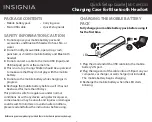
b.
Make copies of important data, if possible.
c.
Replace any failed hard drives and allow the Automatic Data Recovery (ADR) process to rebuild
the data onto replacement drives.
d.
After failed hard drives have been replaced, fault tolerance may again be compromised. If so,
power cycle the system, and if the #02 or #04
ENABLE VOLUME
LCD message is displayed,
press the right push button to re-enable the LUNs.
7.
If using the ACU:
a.
Open the ACU and highlight the faulted LUN (shown with a red drive symbol.)
b.
Select
Re-enable Failed Logical Drive
.
c.
Repeat step a and b for each faulted LUN.
d.
Save the con
fi
guration and then exit the ACU.
8.
If using the MSA-CLI:
a.
Open the MSA-CLI and enter the
show units
command to display information about all of
the LUNs associated with the MSA.
b.
Enter
accept units
to enable all faulted LUNs.
c.
Enter
show units
to verify the status of the LUNs.
d.
Exit the MSA-CLI.
9.
Remember that data loss may have occurred and data on the LUN is suspect.
Best practices when replacing hard drives
Before replacing a degraded hard drive consider the following:
•
Open HP-SIM and inspect the Error Counter window for each physical drive in the same array to
con
fi
rm that no other drives have any errors. For details, see the HP-SIM documentation on the
Management CD.
•
Be sure that the array has a current, valid backup.
•
Use replacement drives that have a capacity at least as great as that of the smallest drive in the array.
The controller immediately fails drives that have insuf
fi
cient capacity.
•
In systems that use external storage enclosures, be sure that the server is the
fi
rst unit to be powered
down and the last to be powered back up. Taking this precaution ensures that the system does not
erroneously mark the drives as failed when the server is powered up.
•
When a hot-pluggable hard drive is inserted, all disk activity on the array is paused while the new
hard drive is spinning up (approximately 10 seconds). If the hard drive is inserted while power is on,
in a fault-tolerant con
fi
guration, data recovery onto the replacement hard drive begins automatically
(indicated by the blinking online LED).
•
Sometimes, a hard drive that has previously been failed by the controller may seem to be operational
after the system is power-cycled, or (for a hot-pluggable drive) after the hard drive has been removed
and reinserted. However, continued use of such marginal hard drives may eventually result in data
loss. Replace marginal hard drives as soon as possible.
•
Back up all data before removing hard drives or changing con
fi
gurations. Failure to do so could result
in permanent loss of data.
•
Remove only hard drives that have been failed or marked as degraded by the controller.
To minimize the likelihood of fatal system errors, take these precautions when removing failed drives:
•
Do not remove a degraded hard drive if any other member of the array is of
fl
ine (the online LED is off).
Exceptions:
• When RAID 1+0 is used, drives are mirrored in pairs. Several drives can be in a failed condition
simultaneously (and they can all be replaced simultaneously) without data loss, as long as no two
failed drives belong to the same mirrored pair.
maintenance and service guide
99
Содержание AD510A - StorageWorks Modular Smart Array 1500 cs 2U Fibre Channel SAN Attach Controller Shelf Hard Drive
Страница 8: ...8 ...
Страница 12: ...12 About this guide ...
Страница 18: ...18 Specifications ...
Страница 60: ...60 LCD panel and message descriptions ...
Страница 96: ...96 Capacity expansion and extension ...
Страница 102: ...102 Hard drive failures and faulted LUNs ...
Страница 108: ...108 SCSI hard drive firmware ...








































